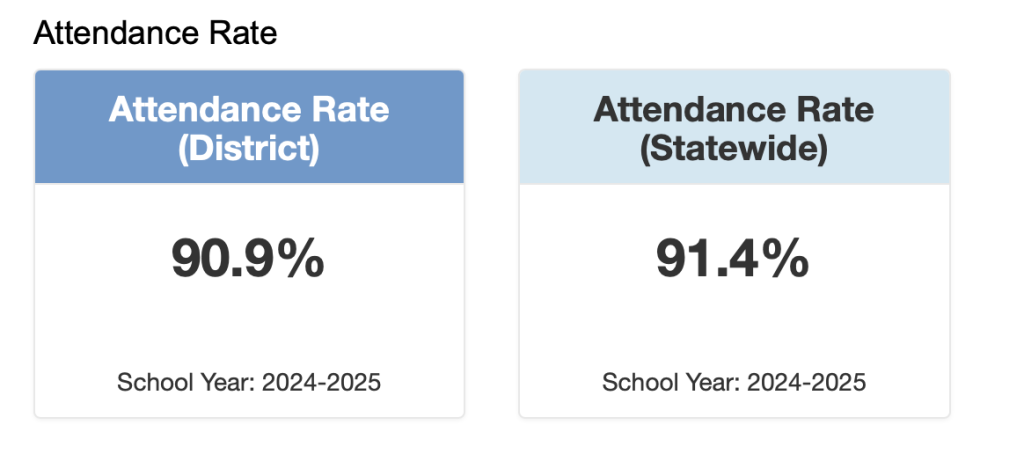Summit School District sees drop in chronic absenteeism and improved attendance

Robert Tann/Summit Daily News
It was just two years ago when 50.5% of Summit School District students were considered chronically absent, and now an effort spearheaded at the middle school has helped cut that rate by around 16%.
Chronic absenteeism is defined as a student missing more than 10% of the school year. For the 2024-25 school year, the district had a chronic absenteeism rate of 34.4%, down from 40.8% in the prior year. While the district’s efforts have helped lower the number of students in that category, it still rises above the state average for the 2024-25 school year, 28.4%.
Individual school absenteeism rates include: 29.5% for Dillon Valley Elementary School; 13.7% for Breckenridge Elementary School; 19.7% for Frisco Elementary School; 27.4% for Snowy Peaks Junior/Senior High School; 29.5% for Silverthorne Elementary School; 40.3% for Summit High School; 41.9% for Summit Cove Elementary School; and 33.3% for Upper Blue Elementary School.
Summit High School saw a 21.1% drop in chronic absenteeism from the 2023-24 school year to the 2024-25 year.
Summit Middle School’s co-vice-principals Erin Dillon and David DeRose, who lead the effort to shrink chronic absenteeism, said they know their work isn’t done. They are already looking forward to next year and have new mechanisms they may deploy involving community partners.
The two said they could talk attendance for hours. They back their initiative with research and data and seek to change the way people think about absenteeism.
DeRose said shifting mindsets from “you’re in trouble because you’re chronically absent” to “you’re a human being facing barriers” is a big lift, but it’s one that employees across the district have taken on and they are now starting to see positive results. He said research shows having one student chronically ultimately can bog down the entire class, so attendance can have some sprawling impacts.
At the Summit School District, addressing chronic absenteeism starts with what Dillon calls “an empathy interview” to understand the student’s reasoning for consistently missing school. The district’s done around 1,200 of these interviews in the past two years, according to DeRose. Dillon said reasons for absenteeism run the gamut, but often barriers including transportation, mental health, family responsibilities can play a role. A plan on how to address these barriers follows the interviews, and DeRose said the district is planning to loop in community partners like nonprofits this year to connect students and families to the resources they need.
Additionally, DeRose said the team behind addressing absenteeism is working with those in student government to see what type of peer opportunities there could be.

“In terms of what is the most effective strategy, it’s a friend saying ‘hey, let’s go to class,'” he said.
Director of communications Kerstin Anderson said the district is also looking to mitigate chronic absenteeism from a curriculum standpoint by introducing engaging classes students are excited about. She said the district continues to build out its future-ready pathways program, meant to gear students up for post-grad life, and seek to get students ample hands-on learning opportunities with local professionals.
Aside from barriers deterring strong attendance, district officials say there’s another culprit: vacations.
“We do hear families a lot saying ‘I’m taking my kid out for this trip, and this trip is a life experience, and it’s educational’ and we certainly don’t want to take away those are valuable experiences….however we want them to consider that the built in time off we have in the school year,” Anderson said.
Dillon said, at the end of the day, every absence strains the system. She said they are looking to address it at all grade levels and looking to set a precedent early with young students that attendance matters. She said important for students and families to know they are not alone and the district is here to help.

Support Local Journalism

Support Local Journalism
As a Summit Daily News reader, you make our work possible.
Summit Daily is embarking on a multiyear project to digitize its archives going back to 1989 and make them available to the public in partnership with the Colorado Historic Newspapers Collection. The full project is expected to cost about $165,000. All donations made in 2023 will go directly toward this project.
Every contribution, no matter the size, will make a difference.






